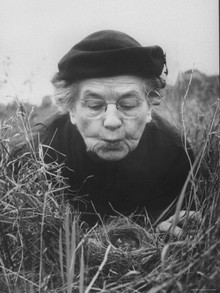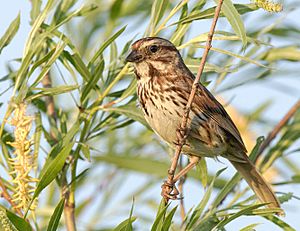Margaret Morse Nice facts for kids
Quick facts for kids
Margaret Morse Nice
|
|
|---|---|

Nice studying a nest of baby field sparrows (1956)
|
|
| Born | December 6, 1883 |
| Died | June 26, 1974 (aged 90) |
| Nationality | American |
| Scientific career | |
| Fields | Ornithology Language acquisition |
Margaret Morse Nice (December 6, 1883 – June 26, 1974) was an American ornithologist, ethologist, and child psychologist who made an extensive study of the life history of the song sparrow and was author of Studies in the Life History of the Song Sparrow (1937). She observed and recorded hierarchies in chicken about three decades ahead of Thorleif Schjelderup-Ebbe who coined the term "pecking order". After her marriage, she made observations on language learning in her children and wrote numerous research papers.
Early life
Nice was born on December 6, 1883, in Amherst, Massachusetts. The daughter of Anson D. Morse, professor of history at Amherst College, and Margaret Duncan (Ely), she was the fourth child with two older brothers Ely and William, an elder sister Sarah, a younger sister Katherine and two younger brothers, Harold and Edward.
She took an interest in nature even as a child; her mother who had studied botany at Mount Holyoke Seminary taught her the names of wildflowers. Her first book dealing with birds was Jenny and the Birds (1860) by Lucy Guernsey which was read out by her mother. The first real bird book she came across was John B. Grant's Our Common Birds and How to Know Them (1891). In her autobiography Research Is a Passion With Me (1979), she wrote that "the most cherished Christmas present of my life came in 1895. Mabel Osgood Wright's Bird-Craft." This book had color illustrations of birds and it guided her to keep notes on local birds when she was twelve years old. With careful note-making she was even able to compare her notes taken when she was 13 years old and compare the rates of fledgling success of young American robins, chipping sparrows, and least flycatchers 61 years later.
She received her B.A. from Mount Holyoke College in 1906 and M.A. in biology from Clark University in Worcester, Massachusetts in 1915. At Clark University she was only one of two women graduate students. She was greatly influenced by G. Stanley Hall and Clifton Fremont Hodge. Hall would influence her later interest in child psychology while Hodge influenced her in conservation. Hodge had notably influenced Anthony R. Kuser to withdraw a $100 reward for passenger pigeon specimens and instead offer a $300 reward for allowing them to nest undisturbed. Hodge kept bobwhite quails at home and Margaret looked after them when Hodge was travelling. For her MA she produced the first comprehensive study on the diet of the northern bobwhite (Colinus virginianus).
Later life
At Clark University, Margaret met Leonard Blaine Nice (referred to by his middle name) and they married in 1908. Blaine served as an instructor in physiology for two years at Harvard Medical School following which the family moved to Norman, Oklahoma, where Blaine had accepted a faculty position in physiology and pharmacology at the university. They had five children, Constance, born 1911, Marjorie, 1912, Barbara, 1916, Eleanor, 1918, and Janet, born 1922. Eleanor died of pneumonia at age nine in Columbus, Ohio.
From 1913 to 1927 she studied the birds of Oklahoma which were published finally as the "Birds of Oklahoma" in 1931. During her time in Oklahoma, she also became very interested in child psychology on which she published 18 articles. Constance was the subject of her first study as part of her M.A. "Development of a Child's Vocabulary in Relation to Environment" (1915). She studied her own children, their vocabulary, sentence length, and speech development. Nice published Marjorie and Eleanor's vocabularies in the Proceedings of the Oklahoma Academy of Sciences (1927). She noted that 19 three-year-old children averaged vocabularies of 910 words and reaching 3000 by six years. This contradicted an old idea that a laborer had a vocabulary of less than 300 words. She also studied mourning doves and wrote about them in several parts. She attended meetings of the National Association of Audubon Societies and came to know many ornithologists in the region. Ornithologist Althea Sherman, 30 years older than Nice, served as a mentor for her early in Nice's career.
In 1927 she moved to Columbus, Ohio, where Blaine had accepted a professorship at the Ohio State University. This move gave her an opportunity to meet more ornithologists in the vicinity. At an AOU meeting in 1927, she was greeted as "Mrs Mourning Dove Nice" by Florence Merriam Bailey. Here she carried out a study of song sparrows that established her as one of the leading ornithologists in the world, recording the behavior of individual birds over a long period of time. She studied two banded pairs of birds, named Uno and 4M, initially and later 69 banded pairs. Beginning in 1929, she spent eight years studying these birds and focused on interactions, breeding, territoriality, learning, instinct and song. In 1931 she met Ernst Mayr at a meeting of the American Ornithologists' Union (AOU), and he was delighted to meet an American who was "interested in more than faunistic records and pretty pictures" and encouraged her to write and arranged the publishing the results of her studies. Following the publication Nice was elected the first woman president of the Wilson Club and became the fifth woman to receive membership in the AOU, followed by a fellowship in 1934.
In 1932 the family went to Europe to attend the International Physiological Congress in Rome. In 1938 she spent two months studying the habits of captive birds with Konrad Lorenz in Austria. after the family moved to Chicago in 1936, she later became the vice-president of the Chicago Ornithological Society and the director of the Illinois Audubon Society. She wrote two popular books on her studies, The Watcher at the Nest (1939) and The Behavior of the Song Sparrow (1943).
Towards the end of the Second World War, she worked along with Joe Hickey and others to help European ornithologists. As a supporter of wildlife and conservation, Nice fought to preserve the Witchita Mountains Wildlife Refuge, the Dinosaur National Monument, and the California redwoods, among other projects.
Like her mentor Althea Sherman, most of Nice's scientific endeavors were self-funded, which was important because of widespread gender discrimination in scientific circles at the time.
Margaret Morse Nice died in Chicago on June 26, 1974, from arteriosclerosis, two months after the death of her husband.
Contributions to ornithology
Nice worked on the life-histories of birds at a time when most of the focus was on collection, description and geographic listing. Her work on the song sparrow is considered a landmark and Deborah Strom wrote in Bird Watching with American Women (1986) that her work was so vast and difficult that the mind boggles at the time and patience required. Ernst Mayr wrote that Nice almost single-handedly initiated a new era in American ornithology and the only effective counter movement against the list-chasing movement. Her first research paper was published with the help of Mayr and Erwin Stresemann in the German Journal für Ornithologie in 1933 and 1934 because American journals would not accept such long articles.
Nice wrote nearly 250 papers on birds, 3,000 book reviews and several books including the Birds of Oklahoma (1924, 1931), The Watcher at the Nest (1939) and her autobiography. Her autobiography was published posthumously with a preface by Konrad Lorenz.
Honors
Nice was made an honorary member of the British, Finnish, German, Dutch, and Swiss ornithological societies. She received the AOU's Brewster Medal in 1942 for her studies of the song sparrow, becoming the second woman to receive it after Florence Merriam Bailey. She received two honorary doctorates, one from Mount Holyoke College during a class reunion (1955) and another from Elmira College (1962). Dean Richard Bond of Elmira College said about her:
She used the outdoors near her home as her laboratory and common species of birds as her subject. In so doing, she joined the ranks of the eminent ornithologists of all time, who saw so much in what appeared common to so many
Ornithologist Robert Dickerman named a Mexican subspecies of song sparrow (Melospiza melodia niceae) after her.
In 1997 the Wilson Ornithological Society established the Margaret Morse Nice Medal for work in ornithology.
Images for kids
See also
 In Spanish: Margaret Morse Nice para niños
In Spanish: Margaret Morse Nice para niños



